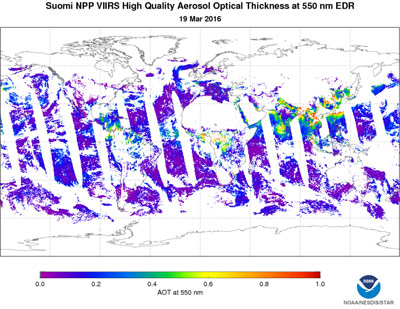Aerosols
Team Leads:
Product Description
EPS AOD, APSP Algorithm Overview (AOD):
- EPS: Enterprise Processing System;
AOT/AOD: Aerosol Optical Thickness/Depth;
APSP: Aerosol Particle Size Parameter - Designed to work with VIIRS and ABI (AHI) observations
- Separate algorithms over land and water:
- Water: MODIS heritage; Includes large inland water bodies
- Land: separate paths for dark and bright surface:
Dark surface: combines two "flavors" of the "dark-target" approach;
Bright (snow-free) surface: regional ratios of surface reflectances
- Uses SW for AOD, SW+IR for internal test, masks (cloud, snow/ice, etc.), ancillary data (P, TPW, ozone, wind)
EPS AD (Aerosl Detection) Algorithm Overview (ADP):
- Input Reflectances: 412, 440, 2250 µm
- Internal Tests:
Spatial Variability Test: 412 µm (land); 865 µm (water)
Turbid Water Test: 488 µm, 1.24 µm, 1.61 µm, 2.25 µm
Bright Pixel Test:1.24 µm, 2.25 µm
NDVI Test: 640 µm, 865 µm
Snow Test: 865 µm, 1.24 µm + IR - Absorbing Aerosol Index (AAI); Dust Smoke Discrimination Index (DSDI)
Product and Data Access
Products and data:
EDR Long Term-Monitoring
Documentation
EPS AOD, APSP Algorithm Output:
AOD at 550 µm and at SW channels (M1 to M11; AOD range: -0.05 to 5.0);
ÂngstrÕm exponents calculated from AOD at two pairs of wavelengths (M4,M7 and M7,M10 µm) over ocean
EPS AD Algorithm Output:
Dust, Smoke, Ash products
Users
NOAA Earth System Research Laboratory (ESRL); NOAA Joint Center for Satellite Data Assimilation (JCSDA); NOAA National Centers for Environmental Prediction (NCEP) Environmental Modeling Center (EMC); University at Albany, State University of New York; Naval Research Laboratory (NRL); NOAA Ocean & Atmospheric Research (OAR)
Future Improvements
AOD:
- Update spectral surface reflectance relationships to minimize seasonal and regional biases
- Examine causes of systematic error in spectral AOD; apply fix
ADP:
- Account for surface contribution to TOA reflectances in computing absorbing aerosol index
- Introduce geometry and location dependent thresholds used in spectral tests
- Develop an approach to determine surface smoke and dust concentrations

